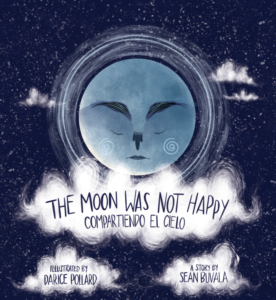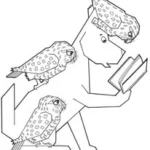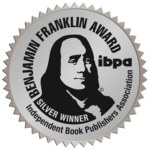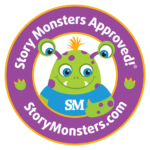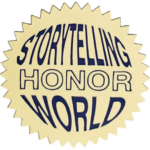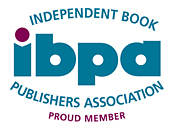Discussion: My Expansion
David:
Hey everyone, welcome back for another discussion of a great book. Today, we will examine My Expansion, a children’s book creating quite a buzz. 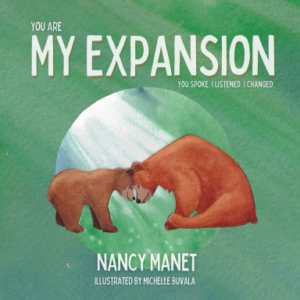
Taylor:
It is. It has these beautiful illustrations, and the story is very sweet.
David:
Yeah, and we actually have quite a bit of material on this one. We’ve got some interviews with the author and illustrator, some early reviews, and even an early copy of the book so we can dive in and see what makes it tick.
Taylor:
Definitely a lot to unpack.
David:
So let’s start with the author, Nancy Manet. Now what’s interesting here is that she’s actually a singer-songwriter. This is her first foray into children’s literature.
Taylor:
You can definitely tell. Her background in music shines through in the writing. The language is very lyrical and very engaging.
David:
Yeah, it’s almost poetic. So, that adds a unique flavor to the book.
Taylor:
Definitely.
David:
Now, on the visual side, we have Michelle Buvala. Her illustrations are striking. They add a whole other dimension to the story.
Taylor:
Yeah, she works with hand-cut watercolors, pens, and ink. And she even uses this really unique technique called watercolor cut paper collage.
David:
Watercolor cut paper collage? Yeah. That’s pretty interesting.
Taylor:
It gives the illustrations a tactile, almost earthy feel.
David:
And you know what else is interesting? Her studio is actually located in Arizona.
Taylor:
Oh wow. I bet that environment influences her work.
David:
It would be surprising, right? You can almost sense the warmth of that environment in the illustrations.
Taylor:
You really can. There’s a definite warmth. There’s a tenderness.
You can almost feel the sun.
David:
Okay, so we’ve got a singer-songwriter for an author and an artist working in a mesquite tree grove. It sounds like the perfect recipe for a heartwarming story.
Taylor:
It does.
David:
So, let’s discuss the story My Expansion. It centers around Big Bear and Cub. Without giving too much away, what’s at the heart of their journey?
Taylor:
At its core, My Expansion is a story about embracing authenticity and challenging the rigid expectations we sometimes place on ourselves and others.
David:
Ah, that’s interesting. So you’ve got Big Bear, who I’m guessing represents a more traditional way of thinking?
Taylor:
Exactly. Big Bear is like the embodiment of those expectations of how things should be.
David:
And Cub, I’m assuming, represents a more free-spirited approach to life.
Taylor:
Precisely. Cub is all about individuality and self-expression. They don’t want to be confined by those expectations.
David:
So, there is this clash between tradition and individuality, between what is expected and what feels true to oneself.
Taylor:
Yeah, you could say that. And that clash is what drives the narrative.
David:
I’m already starting to see those deeper layers you mentioned.
Taylor:
It’s there, right beneath the surface.
David:
One thing that struck me in the interviews was Nancy’s discussion of the challenges of unconditional love. It seems that Big Bear grapples with this issue.
Taylor:
You’re right. There’s a real tension there. It’s like Big Bear wants to love Cub unconditionally, but they’re also struggling with their upbringing and their own beliefs about how things should be.
David:
Ah, so it’s not just about accepting Cub for who they are. It’s about reconciling that acceptance with their own deeply held beliefs.
Taylor:
Precisely. It’s a complex emotional journey for Big Bear, making the story so relatable.
David:
There’s a line in the book that captures this struggle. And it goes, You don’t believe all that I do. Rise.
Never stop being the authentic you.
Taylor:
Oh, that’s a good one.
David:
It’s powerful, right?
Taylor:
Yeah.
David:
Especially for a children’s book.
Taylor:
It is. It also speaks to the idea that true love means accepting someone for who they are, even if their beliefs or choices differ from our own.
David:
Now, speaking of personal experiences, Nancy has been pretty open about how her journey as a parent heavily influenced this book.
Taylor:
Oh, yeah, definitely. And knowing that adds a whole other layer of depth to the story.
David:
So it’s not just a fictional tale.
Taylor:
Yeah.
David:
It’s rooted in real-life struggles and triumphs.
Taylor:
Exactly. And I think that’s one of the things that makes it so compelling.
David:
Before we move on, I want to touch on the publisher briefly. Small Tooth Dog Publishing Group. They’re known for diverse books.
Taylor:
They’ve got a great reputation for that.
David:
And My Expansion definitely seems to fit right in with their mission.
Taylor:
It does. The whole message of embracing individuality and encouraging acceptance aligns perfectly with their values.
David:
It’s nice to see a publisher that’s so dedicated to those values.
Taylor:
It’s refreshing.
David:
OK, back to the story. So we have Big Bear and Cub, but are there any other characters or elements that add to the narrative?
Taylor:
Well, one thing that stands out is the use of nature. There are all these references to trails and journeys and the world’s vastness. It’s like nature is a metaphor for Big Bear’s internal journey.
David:
I like that. It’s like the natural world is mirroring Big Bear’s emotional landscape.
Taylor:
Exactly. And I think that’s where Michelle’s illustrations really shine. She captures that sense of nature so beautifully.
David:
Yeah, we talked about her technique in her studio. But what about the emotions her art evokes? You mentioned warmth, but is there anything else that stands out?
Taylor:
There’s a real joy, especially in the scenes where Cub explores and expresses their individuality. You can almost feel the freedom radiating off the page. When Big Bear finally embraces Cub’s individuality, there’s a sense of peace and resolution.
David:
So, it’s visually rich and emotionally resonant.
Taylor:
It is.
David:
OK, we’ve discussed the creative team, the plot, and the art. But let’s not forget about our listeners. Why should they care about My Expansion?
What makes this book worth checking out?
Taylor:
What makes it so special is how it speaks to the universal human experience of reconciling our sense of self with the expectations of others. Whether you’re a parent, a child, or someone who’s ever felt different or struggled to be accepted, this book has something to offer.
David:
So it’s not just a sweet story about a bear and their cub. It’s about something much bigger than that.
Taylor:
Exactly. It’s about embracing our individuality, challenging the norms that try to box us in, and finding the courage to be our authentic selves.
David:
And that’s a message we can all get behind.
Taylor:
Absolutely.
David:
OK, before we move on, I want to circle back to something you mentioned earlier, the watercolor cut paper collage. What is it about that technique that makes it so special? Why do you think Michelle chose to use it for this book?
Taylor:
Well, it’s interesting because it really allows for a unique kind of depth and dimension. It’s almost like creating a three-dimensional image on a flat surface. You get these layers of texture and color.
It’s quite striking.
David:
So, it’s not just about visual appeal; it’s about adding a tactile dimension to the art.
Taylor:
Exactly. And that tactile quality adds to the emotional depth of the story. You know, there’s a scene where a cub is exploring the forest.
Michelle’s use of layered paper to create the texture of the leaves and branches makes you feel like you’re right there with Cub. You experience the world through their eyes.
David:
Oh, I see. It’s like she’s inviting the reader to reach out and touch the illustrations, to become a part of the story themselves.
Taylor:
Exactly. It’s a really clever way to engage young readers, especially those who are drawn to those kinds of sensory experiences.
David:
It’s almost like the art style itself is an extension of the book’s message. Exploring the world in all its fullness, embracing every texture and nuance.
Taylor:
That’s a great way to put it.
David:
So we’ve got a lot to think about already. But there’s still much more to explore. We’ll be back after a quick break to dive deeper into the themes of My Expansion and discuss its potential impact on readers of all ages.
Taylor:
As we continue our deep dive into My Expansion, let’s take a closer look at how the book tackles the dynamics between parents and children.
David:
Yeah, that’s a really important aspect because it’s not just about Big Bear learning to accept Cub. It’s about the whole push-and-pull that parents experience.
You know, wanting to guide your child, but also wanting them to find their own way.
Taylor:
Right. It’s that balance between holding on and letting go. And it’s not always easy, especially for parents who come from more traditional backgrounds where there’s a very specific idea of how things should be.
David:
And Big Bear definitely seems to be struggling with that.
Taylor:
Yeah, you can sense that internal conflict. It’s like they’re trying to reconcile their own upbringing with the reality of their very unique Cub.
David:
I’m already seeing parallels to Nancy’s experiences as a parent.
Taylor:
It’s there, isn’t it? That struggle to embrace your child’s individuality, while also trying to stay true to your own values.
David:
It’s like a universal theme.
Taylor:
Yeah.
David:
So many of us have felt tension between what’s expected of us and what we truly desire.
Taylor:
Exactly. And My Expansion really taps into that. It’s like a microcosm of that larger struggle.
David:
We’ve talked about Big Bear’s journey of acceptance, but what about Cub? What role do they play in all of this?
Taylor:
Well, it’s interesting because Cub’s unwavering authenticity drives the story forward. Their very existence challenges Big Bear’s preconceived notions and forces them to confront their own biases.
David:
It’s almost like Cub is a catalyst for Big Bear’s transformation.
Taylor:
Exactly. And that’s a powerful message for young readers. Seeing a character who’s so unapologetically themselves, it’s inspiring.
David:
It’s a reminder that we don’t have to dim our light to make others comfortable.
Taylor:
Right. We can be our true selves, even if it makes some uncomfortable.
David:
So it’s not just a sweet story about a bear and their cub. It’s a challenge to those rigid expectations that we often place on ourselves and others. You got it.
Taylor:
We’ve been exploring these dimmer themes, but let’s not forget that this is also a children’s book. It’s meant to be enjoyed.
David:
Oh, absolutely. And it is. It’s got this nice balance between those deeper themes and a sense of playfulness.
The language is fun, the illustrations are bright, and the story itself is heartwarming.
Taylor:
That’s so important that it can be enjoyed on multiple levels. Younger readers might not grasp all the nuances, but they can still connect with the characters and the story itself.
David:
Right. And those deeper messages might still resonate with them on a subconscious level.
Taylor:
So it’s a story that can grow with the reader.
David:
I think so.
Taylor:
Now, we talked about how Nancy’s experiences inspired the story, but what about Michelle? How does she approach this project as the illustrator?
David:
Well, her art really complements the themes of the book. Her use of earthy colors, like browns, greens, and blues, creates a sense of warmth of connection to nature.
Taylor:
And those colors also evoke a sense of peace and tranquility, which I think aligns really well with the overall message of acceptance. Definitely. And then you have her signature style, that watercolor cut paper collage.
It adds such a unique texture to the illustrations.
David:
You keep coming back to that technique. It’s clearly something special.
Taylor:
Well, it’s fascinating how she uses it. It allows for incredible depth and dimension. When you look at the illustrations up close, you can see all these layers, these subtle variations in color and texture.
It’s almost like creating a miniature world within each image.
David:
Oh, I see what you mean. It’s like she’s taking those flat pieces of paper and building something intricate and complex with them.
Taylor:
Yeah, it’s pretty amazing. And I think it mirrors the idea that life itself is not about being smooth or perfect. It’s about embracing those bumps and edges that make us unique.
David:
That’s a beautiful analogy. It gets to the heart of what My Expansion is all about.
Taylor:
It’s about celebrating individuality in all its forms.
David:
Now, we’ve been focusing on the positive aspects of the book, but I’m curious: do you think there’s a chance that this story might rub some people the wrong way, you know, given its message of acceptance and challenging traditional norms?
Taylor:
That’s a good point. Whenever you challenge deeply held beliefs, there’s bound to be some pushback.
David:
Do you think that’s necessarily a bad thing?
Taylor:
Not necessarily. Sometimes those uncomfortable conversations are the ones that lead to the most growth.
David:
So maybe My Expansion can be a catalyst for those conversations, a way to open up dialogue about important issues.
Taylor:
I think it has the potential to do that.
David:
So it’s not just a heartwarming children’s story. It’s a conversation starter, a thought-provoking.
Taylor:
It is. And I think that’s one of the things that makes it so special.
David:
OK, we’ve talked about the impact this book might have on families and communities. But what about its intended audience? Is it just for children?
Or do you think adults can get something out of it as well?
Taylor:
Oh, I think it definitely has something to offer adults. You know, the themes of acceptance and individuality, they’re universal. Anyone who’s ever struggled with those concepts can find something meaningful in this story.
David:
So it’s a book that can be shared and enjoyed by people of all ages. I’m curious about something else. We talked about how Michelle’s illustrations enhance the story.
But what specifically do you think young readers will connect with?
Taylor:
Well, kids are drawn to bright colors and fun details. And Michelle’s illustrations have plenty of both. I think the love, the expressiveness of the characters, the way Cubs’ movements show their free spirit, and how Big Bear’s posture changes as they struggle with their beliefs.
David:
And there’s that tactile quality, too, right? The way illustrations are almost like a sensory experience for young readers.
Taylor:
Those layered textures really invite exploration.
David:
So it’s not just a visual story. It’s a tactile one as well.
Taylor:
You got it. It engages the reader on multiple levels.
David:
Now, before we wrap up part two, I want to circle back to the idea of tension between tradition and individuality. Could you talk a bit more about how that plays out in the story, particularly through Big Bear’s character?
Taylor:
Sure. Big Bear is a really interesting character because they represent that struggle so many of us face. You know, when we’re confronted with ideas that challenge our ingrained beliefs, Big Bear is rooted in tradition, in a sense of how things should be.
David:
But then along comes Cub and everything gets turned upside down.
Taylor:
Exactly. And it’s through that confrontation that Big Bear, and by extension, the reader, starts to understand the importance of expanding their worldview.
David:
It’s like a journey of personal growth that’s mirrored in the physical journey that Big Bear and Cub take throughout the story.
Taylor:
That’s a great observation. And it makes me think about how this book might resonate with people who have gone through similar experiences in their own lives. You know, maybe coming to terms with their own identity or accepting the choices of loved ones.
David:
So it’s not just a whimsical tale. It’s a story about real life struggles and the courage to embrace change.
Taylor:
It is. And it offers a really powerful message of hope. It reminds us that growth can be uncomfortable, even painful at times.
But it’s through that process that we can create space for greater understanding and love.
David:
That’s a beautiful message and one that we can all learn from.
Taylor:
Definitely.
David:
And we’re back for the final part of our deep dive into My Expansion. We’ve covered a lot of ground already. But before we wrap things up, I want to talk about the book’s potential impact on a larger scale.
What kind of conversations could this book spark in families, classrooms, or even communities?
Taylor:
Well, I think it has the potential to really open up some important dialogues about acceptance diversity, and individuality. Imagine families reading this book together and using it as a starting point to talk about what it means to embrace those who might be different from us.
David:
It could be a really gentle way to approach topics that can sometimes be tough to talk about, especially with younger kids.
Taylor:
Exactly. And in a classroom setting, I could see teachers using My Expansion to explore themes of empathy and understanding, you know, encouraging kids to celebrate each other’s unique qualities and really see the beauty in our differences.
David:
And I bet it could inspire some pretty amazing art projects too, especially with Michelle’s illustrations as a guide.
Taylor:
Oh, absolutely. Those illustrations are just begging to be recreated in all sorts of creative ways. And beyond families and classrooms, I think My Expansion could even spark conversations on a community level, you know, about building bridges between people from different backgrounds and creating a more inclusive society.
David:
So it’s not just a story. It’s a tool for positive social change.
Taylor:
I think so. It has the potential to make a real difference in the world.
David:
We’ve talked a lot about the positive potential of My Expansion, but realistically, not everyone will love this book. Some people might even find it controversial.
Taylor:
That’s true. Challenging, deeply held beliefs can be uncomfortable for some people. And My Expansion definitely pushes us to question our assumptions and embrace a more nuanced understanding of the world.
David:
So it’s a book that might ruffle some feathers.
Taylor:
It might. But you know what? Sometimes those ruffled feathers are a sign of growth.
David:
That’s a good point. If we don’t challenge ourselves and each other, are we really growing?
Taylor:
Exactly. Discomfort can be a catalyst for change.
David:
So My Expansion is an invitation to step outside of our comfort zones and embrace the unknown.
Taylor:
That was beautifully said. It reminds us that growth often happens when we’re willing to question our beliefs and celebrate the beauty of diversity.
David:
That message feels more relevant than ever these days.
Taylor:
It does, doesn’t it? With all the division and polarization in the world, it’s easy to forget that there’s still so much good out there.
David:
My Expansion reminds us of that.
Taylor:
It does. It reminds us that we can choose love, acceptance, and understanding, even in the face of our differences.
David:
And those choices, while not always easy, can make a real difference in the world.
Taylor:
They can. And that’s a powerful message to carry with us.
David:
As we wrap up this deep dive, I want to circle back to Nancy briefly. What do you think she hopes readers will take away from My Expansion?
Taylor:
Well, given her journey and what she shared in interviews, I think she wants us to understand that embracing individuality, both in ourselves and others, is a sign of strength, not weakness.
David:
It’s about letting go of those limiting beliefs that hold us back and opening ourselves up to a more expansive way of being.
Taylor:
Exactly.
David:
That’s a beautiful message and one that I think we could all benefit from hearing.
Taylor:
I agree. This message speaks to the heart of My Expansion. It’s a call to be more open-minded, compassionate, and accepting.
David:
And that’s something we can all strive for.
Taylor:
Absolutely.
David:
Well, I think that’s a perfect note to end on. We’ve covered a lot of ground in our deep dive into My Expansion And I hope this conversation has given you a new perspective on this remarkable book.
Remember, the world needs more expansion, more understanding, more love. So go out there and make it happen.
****
This article is a compilation of a variety of sources regarding the My Expansion book, including live transcripts, reviews, marketing materials, a.i outlining, and direct input from the publisher.
